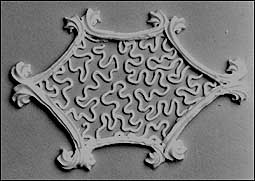
Lacework is a special cake decorating technique that is particularly suited to wedding, shower and fondant-covered cakes. Usually done in white on pastel cakes for feminine occasions, lacework requires nearly perfect pressure control. Continued practice should give you pleasing results.
Apply lacework to an entire cake or within a pattern on a cake. Use thinned buttercream or royal icing for buttercream frosted cakes; thinned royal or boiled for fondant-covered cakes. (For this lesson always use thinned buttercream icing.)
In Brief
Icing: thin consistency
Tip: plain tip 1
Positions:
Bag: slightly less than 90° angle
Tip: close enough to cake so that icing attaches without scraping cake with tip and without flattening icing strings.
Apply lacework to an entire cake or within a pattern on a cake. Use thinned buttercream or royal icing for buttercream frosted cakes; thinned royal or boiled for fondant-covered cakes. (For this lesson always use thinned buttercream icing.)
In Brief
Icing: thin consistency
Tip: plain tip 1
Positions:
Bag: slightly less than 90° angle
Tip: close enough to cake so that icing attaches without scraping cake with tip and without flattening icing strings.
Sequence:
Beginning and ending at edge that will later be covered with a border, pipe a meandering icing string line.
Move tip up, around and down to produce a lacy effect (should look like a series of "R's" or "S's").
Do not let lines touch or cross.
Let dry before adding other icing trims.
Explanation:
Hold your decorating bag at slightly less than a 90° angle.
Keep tip close enough to cake so that icing attaches without scraping cake with tip and without flattening icing strings.
Always begin and end cornelli lace at edge that will later be covered with a tip 14 border.
Cornelli lace is a series of smooth "R's" or "S's".
Cornelli lace lines never cross or touch.
Cornelli lace does not follow any type of pattern.
Beginning and ending at edge that will later be covered with a border, pipe a meandering icing string line.
Move tip up, around and down to produce a lacy effect (should look like a series of "R's" or "S's").
Do not let lines touch or cross.
Let dry before adding other icing trims.
Explanation:
Hold your decorating bag at slightly less than a 90° angle.
Keep tip close enough to cake so that icing attaches without scraping cake with tip and without flattening icing strings.
Always begin and end cornelli lace at edge that will later be covered with a tip 14 border.
Cornelli lace is a series of smooth "R's" or "S's".
Cornelli lace lines never cross or touch.
Cornelli lace does not follow any type of pattern.
Found at Wilton.com




0 comments:
Post a Comment